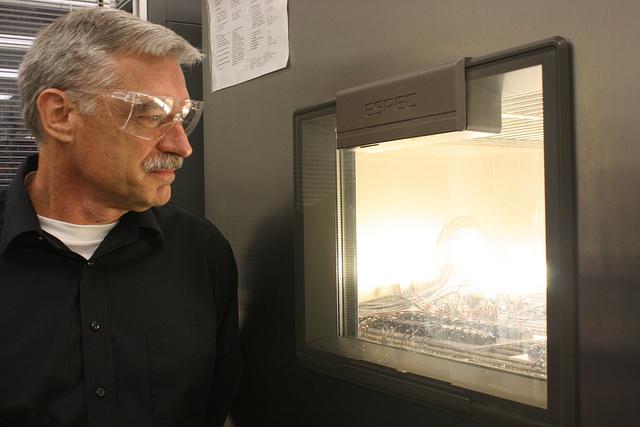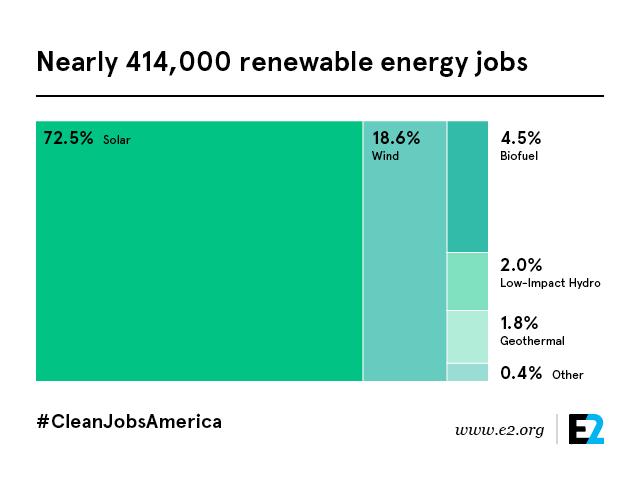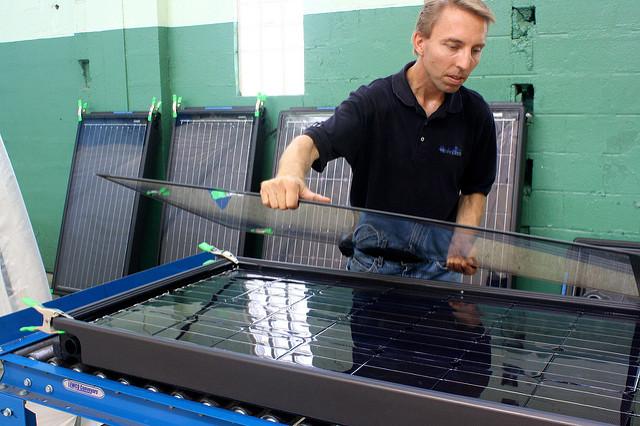While the U.S. Supreme Court in February 2016 decided to stay the Clean Power Plan, temporarily halting its implementation, many states, confident in the rules legal merits, are continuing to make progress toward implementing it.
Report: Clean Energy Economy Employs More than 2.5 Million Americans, Poised for More Growth
Lauren Kubiak | NRDC
More than 2.5 million Americans work in clean energy, according to a new study released yesterday from the national nonpartisan business group Environmental Entrepreneurs (E2), an NRDC affiliate. These men and women install solar panels, manufacture electric vehicle parts, and retrofit our homes, schools and businesses to make them more energy efficient. They build wind turbine blades, invent battery technologies, and assemble the most energy-efficient appliances on the planet.
And thanks to the Clean Power Plan, global carbon-reduction commitments in Paris, the renewed tax credits for wind and solar, and other state and federal policies, the United States is well-positioned to continue to grow its clean energy economy through 2016 and beyond.
Energy Efficiency Driving Job Growth
Energy efficiency is the largest job-creator, with nearly 1.9 million Americans working with efficient heating, ventilation and air conditioning (HVAC) products, manufacturing efficient appliances, creating advanced materials and insulation, and manufacturing or installing efficient lighting products.
Of these workers, about a third work in HVAC (Heating, Ventilation and Air Conditioning) industries, 17 percent designing and manufacturing and installing efficient lighting, 15 percent in advanced energy-saving materials, and the remainder in ENERGY STAR® appliances (the designation for the most efficient models on the market) and other efficiency fields.
Energy efficiency workers are helping America reduce its energy use while driving economic growth. They helped the nation improve its energy productivity (i.e., the GDP-to-energy-consumed ratio) by 13 percent between 2007 and 2015 – a 2.4 percent decrease in U.S. primary energy consumption while the economy grew by 10 percent, according to Bloomberg New Energy Finance.
As my colleagues write, NRDC has a dedicated history working to improve energy efficiency through appliance federal standards, state efficiency requirements, and utility investment.
Reducing energy waste in lighting is one of the best ways to expand our economy by saving consumers money. Recently proposed updates to light bulb standards, which my colleague has written about here and will go into effect in 2020, will save consumers and businesses about $12.5 billion annually. These standards, and those phased in beginning in 2012, support 328,000 workers in the energy-efficient lighting industry.

Former GE senior lighting physicist Gary Allen led efforts to develop the omnidirectional LED bulb, which improves lighting quality while cutting energy waste and saving businesses and homeowners moneyPhoto: Lauren Kubiak
Federal appliance standards have helped spur an industry that supports 162,000 workers who are helping build ENERGY STAR appliances like washing machines, refrigerators, freezers, and dishwashers. In 2014, alone federal appliance standards implemented since 1987 saved Americans $60 billion on utility bills.
Strengthening standards like these will only serve to grow our economy and create more jobs.
Renewables Make Up Significant Share of Jobs
Nearly 414,000 people are currently employed in renewable energy generation in the United States – 299,000 work in solar energy (about 209,000 full-time or near full-time), more than 77,000 in wind, and the remainder in biofuels, low-impact hydroelectric power, geothermal, or another renewable energy industry.

The solar industry is a significant driver of renewable energy job growth Environmental Entrepreneurs
The solar industry in particular has experienced explosive growth in recent years; 2015 marked the third consecutive year when the industry grew at a 20-percent rate.
Wind industry also posted strong job numbers. As a result of expirations followed by renewals of the Production Tax Credit (PTC), a 2.3 cents per kilowatt-hour credit for wind generation, the industry has previously experienced boom-and-bust cycles. But in the waning days of 2015, Congress as part of a broader tax package extended the PTC and the Investment Tax Credit (ITC) for solar energy. This extension gives wind and solar industries seven years of planning certainty. This will lead to deployment of 90 additional gigawatt-hours of wind and solar energy, and support an additional 220,000 solar jobs by 2020.

A worker puts the final touches on a combined solar PV-T panel at a manufacturing plant in Detroit, MI
Photo: Lauren Kubiak
Advanced Vehicles
Advanced vehicle industries including hybrid, electric, and fuel cell vehicles, employ nearly 170,000 workers. Thanks to 54.5 mpg fuel efficiency standards, a growing electric vehicle fleet, and increased focus on lowering the emissions of our automotive fleet, we can expect this number to continue to grow.
Looking Ahead Through 2016 and Beyond
The more than 2.5 million U.S. clean energy workers demonstrate that clean energy is a strong industry that’s adding economic and environmental value to the nation. Thanks to federal appliance standards, as well as the PTC and ITC, we can expect clean energy to continue its steep growth trajectory. But to capitalize on clean energy’s true potential, plenty of work remains.
The federal Clean Power Plan, the first ever carbon emission limits on existing power plants that will reduce power-sector carbon emissions 32 percent from 2005 levels by 2030, is one way to capitalize on that potential. Designing strong Clean Power Plan state implementation plans that prioritize renewables and efficiency as core compliance strategies is one of the biggest ways to ensure clean energy continues to grow and add jobs each year.
While the U.S. Supreme Court in February 2016 decided to stay the Clean Power Plan, temporarily halting its implementation, many states, confident in the rule’s legal merits, are continuing to make progress toward implementing it. States can also continue to enact and strengthen renewable portfolio standards(requiring specific amounts of energy from renewable sources) and energy efficiency standards, and ensure energy efficiency investment in their resource plans, to continue growing their clean energy economies – and adding the kinds of good jobs that accompany this growth.
This post originally appeared on NRDC's Website
Lauren Kubiak focuses on development and implementation of states’ renewable energy and energy-efficiency policies within the context of the U.S. Environmental Protection Agency’s Clean Power Plan. She also studies and reports on the economic impacts of energy efficiency and renewable energy across different industries. Kubiak received both her bachelor’s and master’s degrees from Stanford University’s Earth Systems program. She is based in New York.
The content & opinions in this article are the author’s and do not necessarily represent the views of AltEnergyMag
Comments (0)
This post does not have any comments. Be the first to leave a comment below.
Featured Product

